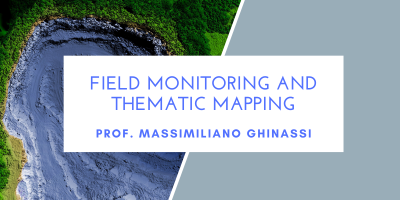Field Monitoring and Thematic Mapping

Period: Second semester
Course unit contents:
- Mapping geological features and monitoring landscape evolution: overview, applicability, and objectives.
- Recall of basic principles of geology and geomorphology suitable for mapping, including concepts such as surface topography, geometries of geological units (e.g., sedimentary, magmatic bodies), deformations (e.g. faults, folds) and litho- and chrono-stratigraphy.
- Reading of a geological map: i) determining the orientation of geological boundaries, stratal surfaces, and fault planes; ii) analyzing the geometry of geological units; iii) understanding the relationship between modern deposits and topography
- Geological cross sections and reconstruction of the genesis and subsequent modification (e.g., deformation) of geological units.
- Geological field mapping includes: i) measuring the attitude of geological surfaces (e.g., stratal surfaces and fault planes); ii) integrating geological field data with topographic maps; iii) creating a geological map based on field data collection
- Reading thematic maps (e.g. including representation of surface processes and their effects) and integration with geological datasets.
- Monitoring landscape evolution (e.g. quantifying mass transport along slopes) in a definite geological frame
- Application of monitoring technique to definite study cases (case studies of monitored slope displacements such as Tessina and Lamosano landslides in northern Italy)
Planned learning activities and teaching methods:
The course will use classroom teaching to impart knowledge of principles related to geological field mapping and monitoring techniques. Once this foundational knowledge is acquired, it will be largely consolidated through practical activities, including both laboratory- and field-work. Laboratory activities will involve: i) creating geological cross-sections and understanding the 3D geometries of geological bodies (also using 3D virtual models); ii) collecting data on the spatial orientation of geological surfaces; iii) recognizing mass wasting processes in the field and mapping them with advanced technologies.
Fieldwork activities will offer opportunities to integrate acquired skills and apply the knowledge gained in practical settings. Over the course of three days, participants will engage in fieldwork to collect geological and geomorphological data, and to apply techniques for monitoring specific processes. The data collected in the field will be analyzed and discussed subsequently promoting discussion among students. A geological map and cross-section derived from these data will be included in the final exam assessment.
Teaching methods may be adapted to accommodate specific student needs (e.g., fieldwork limitations, participation to the end-of-course field trip) provided that these needs are communicated to the instructor through the appropriate institutional procedures. Similarly, individual and flexible learning paths may be arranged for students with certified SEN or SLD, depending on feasibility and in accordance with institutional policies. In addition to contacting the course instructor, students with disabilities, specific learning disorders, special educational needs, or other health conditions may reach out to the Student Services Office – Inclusion Section to receive more information about available teaching support and tools.
At the end of the course, students will be invited to complete a survey aimed at collecting feedback and suggestions to support the improvement of future editions.
The use of AI tools to prepare all possible elaborates is not allowed.
